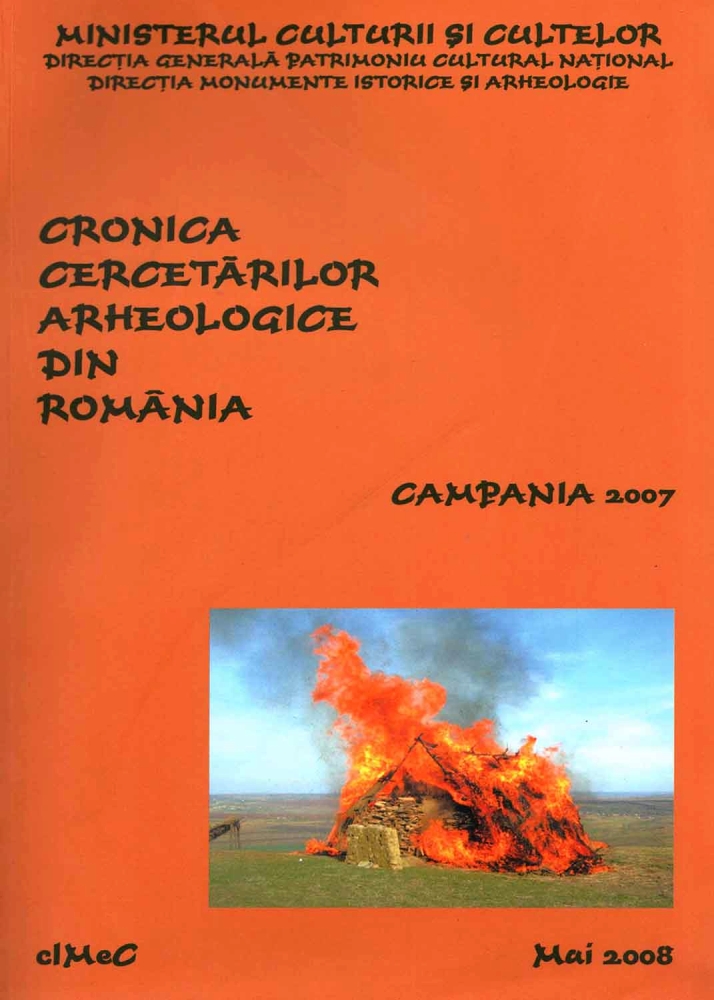Alba Iulia | Punct: str. Izvorului f.n. (proprietatea Ana Paşca) | Anul: 2007
Descriere:
Raport ID:
3823
Anul cercetarii:
Perioade:
Antichitate;
Epoci:
Epoca romană timpurie;
Categorie:
Religios, ritual şi funerar;
Tipuri de sit:
Necropolă;
Cod RAN:
| 1026.18 |
Județ:
Alba
Unitate administrativă:
Alba Iulia
Localitate:
Alba Iulia
Punct:
Str. Izvorului F.N. (Proprietatea Ana Pașca)
Toponim:
Apulum Ii
Localizare:
| 1026.18 |
Fără Ilustrații
Instituții și
Persoane implicate:
Persoane implicate:
| Nume | Prenume | Rol | Instituție |
|---|---|---|---|
| Inel | Constantin | participant | Muzeul Naţional al Unirii, Alba Iulia |
| Oargă | Ovidiu | participant | Muzeul Naţional al Unirii, Alba Iulia |
Raport:
În luna februarie 2007 s-au efectuat cercetări arheologice preventive de către MNUAI, conform contractului de cercetare arheologică şi autorizaţiei pentru săpături arheologice de salvare nr. 11/2007, emisă de MCC. Terenul aflat în proprietatea lui Paşca Ana, este amplasat pe str. Izvorului f.n., iar beneficiarul urmează să construiască obiectivul „locuinţă familială”, fiind situat la cca. 700 m S de monumentul dedicat eroilor Horia, Cloşca şi Crişan amplasat pe B-dul 1 Decembrie, colţ cu str. Izvorului. Obiectivul supus cercetării se află în zona Dealul Furcilor, unde în decursul timpului au fost descoperite vestigii aparţinând necropolei oraşului roman municipium Septimium Apulense.
Cunoscută fiind stratigrafia din zona apropiată obiectivului supus cercetării în vederea descărcării de sarcină arheologică, pe suprafaţa destinată realizării obiectivului şi orientată SSV-NNE, au fost realizate lucrări de decopertare mecanizată sub supraveghere arheologică de specialitate, rezultând o suprafaţă decopertată care are următoarele dimensiuni: Sp.1 = 12 x 8 m.
Suprafaţa Sp.1
Amplasată pe toată suprafaţa destinată viitoarei construcţii, ea dezvăluie următoarea stratigrafie:
0 -0,28 m nivel vegetal;
-0,28 -0,74 m nivelul de culoare brun închis în care nu au fost descoperite materiale arheologice;
-0,74 -0,90 m sterilul arheologic (lut de culoare maro-gălbuie). După decopertarea mecanizată supravegheată arheologic, care s-a realizat până la ad. de -0,65 m, nefiind descoperite materiale arheologice, a fost efectuată răzuirea întregii suprafeţe decopertate, acţiune în urma căreia s-a putut observa conturarea unui mormânt de inhumaţie (notat M1), cu orientarea aproximativă N-S, amplasat pe latura de V a amplasamentului locuinţei. Groapa mormântului este de formă dreptunghiulară şi s-a conturat la ad. de -0,75 m, scheletul fiind descoperit la -1,40 m. La o primă analiză a osemintelor se poate observa că mormântul nu a suferit intervenţii ulterioare înmormântării, însă este vizibil nivelul scăzut de conservare a oaselor scheletului, din care s-a mai putut demonta doar oasele membrelor inferioare şi craniul, în timp ce oasele mici ale degetelor picioarelor, ale membrelor superioare sau partea bazinului şi a coastelor nu au putut fi decât fotografiate şi desenate datorită transformării lor în „făină”, ele neputând fi recuperate. Mormântul nu a oferit inventar, iar materialul osteologic ce a putut fi recuperat a fost transportat la muzeu, pentru viitoare analize antropologice.
Pe baza caracteristicilor de rit şi ritual funerar, precum şi prin analogiile oferite de mormintele apropiate descoperite în această zonă a platoului Dealul Furcilor, deşi nu beneficiem de elemente de inventar care ar fi putut să confirme ipoteza de datare, presupunem că mormântul face parte din necropola romană mai vastă descoperită pe Dealul Furcilor - Podei, posibil ca mormântul să fie datat în sec. III p.Chr.
Acesta a fost singurul complex arheologic descoperit pe suprafaţa destinată viitoarei construcţii.
Rezumat:
Obiectivul supus cercetării se află în zona Dealul Furcilor, unde în decursul timpului au fost descoperite vestigii aparţinând necropolei oraşului roman municipium Septimium Apulense. A fost descoperit şi cercetat un mormânt fără inventar ce face parte din necropola romană mai vastă descoperită pe Dealul Furcilor - Podei, cu o posibilă datare în sec. III p.Chr.



 CC BY-SA 4.0
CC BY-SA 4.0